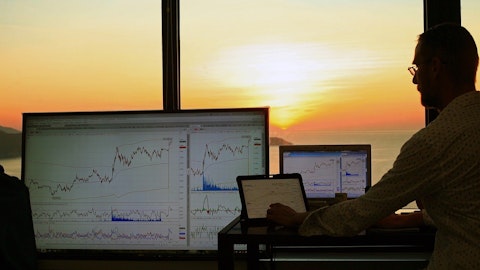Dave Foulkes: I think I would say that the – on a I think that the – all of the things that are constructive trends on a secular basis for Propulsion are still in place. This is really a is the market going to be slightly better than we assumed or slightly worse than we assume? But I would say that we’re very confident that the investment in high horsepower and our overall performance in high-horsepower will yield share gains. I don’t exactly know, how that’s so good and that’s out next to you. But Mercury will end up stronger by the end of next year than it is at the end of this year, I think.
Ryan Gwillim: And probably the other good news is we have done our investment. We’ve done the investment on the capacity. We’ve done our investment on new products. There’ll still be other things, but we’re now at a time where we can harvest those investments and really use them to gain share here moving forward.
James Hardiman: Got it. Appreciate the color. Thanks, guys.
Operator: Our next question is from Xian Siew with BNB Paribas. Please proceed.
Xian Siew: Hi, guys. Thanks for the question. On inventories, you mentioned weeks on hand, you expect to exit the year at about 36 weeks, which is pretty much in line with 2019 and 35%. But I guess given higher floor plan financing, higher ASPs and maybe kind of an uncertain retail market. Do you think like that on hand should be actually lower than 2019? Or how do you think about – how do you think about that?
Dave Foulkes: Yes. I think we’ve – I think we’ve had this kind of back and forwards for a while. What we have always been saying that in the 30s is probably where weeks on hand needs to be, especially at a lower market level. So dealers have a representative selection of our portfolio. On a unit basis, it is lower than 2019, 14,000 units versus 16,000 units. And that is a reflection, obviously, of the overall retail level, but could be, to some extent, the floor plan financing availability and credit limits and that kind of stuff. I don’t see that as a significant issue for us at the moment. I think overall, the predominant desire and alignment between us and our channel partners is to just get the inventory level right and I don’t think that there is a specific issue with credit limits or kind of dollar value of inventory that’s really prevailing at the moment.
I think if you think about it, if retail is flat, obviously, that is 36 weeks on a trailing basis on a forward-looking basis, which seems to us to be extremely appropriate. And the ability to kind of land the plane after a year like this with $9 of EPS and inventory in line. It’s not a bad trick, to be honest. So I think that – I think we feel very comfortable about it.
Xian Siew: Okay great. That makes sense. And then maybe on Propulsion guidance, a bit lower on revenues, but margins were maintained. Maybe can you walk through some of the bridge to hold the margin?
Ryan Gwillim: Yes, I can take that one. The Propulsion Business is larger today as it is has several levers to be able to pull certainly in terms of OpEx, but it starts with the gross margin line frankly. And there, they continue to hold gross margin steady, if not a little bit up even despite volume. And Xian, that’s mainly because of the strength in the high horsepower. So there’s also a bit of mix in there. Obviously, dealer orders were really strong in the quarter, and that comes with a little bit of premium on the earnings front as well. We had a little headwind in currency in the quarter, and we’re hoping that, that abates a bit as we kind of run out the year. But really, that’s a – those are the biggest pieces.
Dave Foulkes: Yes, I just noted we obviously had the one-off issue with a security incident this year, which obviously was an absorption issue for a period.
Ryan Gwillim: That’s right.
Xian Siew: Okay, great. Thank you guys, good luck.
Operator: Our next question is from Craig Kennison with Baird. Please proceed.
Craig Kennison: Hey, good morning. Thanks for taking my question. I wanted to revisit I guess, your base case for retail next year. I know it’s early. But certainly, in my mind, retail being flat next year would be fantastic and well above what I think the market may expect. I would note that Patrick, which is a supplier to this industry, just sit on its call, they have an expectation for a 15% decline next year, and I know they cater to a lower end, but still a pretty wide gap there. So I guess, my question is, what does the recession playbook at Brunswick? And how quickly can you pivot to that to kind of protect the floor and earnings power, whatever you think that might be?
Dave Foulkes: Yes, Craig, I went through the assumptions really that drive us to a kind of a flattish retail assumption next year. I think I’d stand by those at the moment. The call we gave earlier this year about modestly down. Obviously, the market a bit to vary quite a lot, but it kind of came back to where we thought it was. That doesn’t mean that we’re always right. But I think we have a decent feel for this. But I think what you’ve seen this year is but we have all kinds of levers to pull, and we’re very effective at doing it. We began to work on operating expense very quickly this year as market conditions unfolded and pulled out significant operating expense. So as we – and that was obviously progressive during the year.
So on a run rate basis was higher as we go into 2024. But we still have some things that are pretty favorable for us. Obviously, as we see the market softer and generally, market softer across recreation and beyond, the customer supply dynamics change. We’re able to influence pricing somewhat more. We pivot people from whatever they were doing this year to work more on getting COGS reductions, design cost reductions, negotiate cost reductions, all those kind of things, including working on our operating expense lines as well. So I think we still have plenty of levers to pull and we consistently demonstrated how effective we doing that.
Ryan Gwillim: And I would just add Craig, I think you know this, but I’d caution 15% down from this year would be below the level of sales after the GSE. So obviously, everyone is doing their best to forecast the market, but that would seem to be an extremely down scenario given what we’ve seen in the environment even this year.
Dave Foulkes: I wouldn’t – Craig, I wouldn’t also neglect what we can do on the go-to-market side. The new Brunswick Finance solution that we’re just rolling out, I think, is gives us some unique flexibility to offer customers promotional financing of various kinds, kind of bridge them through this period of higher rates. So this is a multitude of levers that we have to pull on the go-to-market side, on the COGS side and on the expense side that I think we could – we’ve shown our effectiveness in doing.



